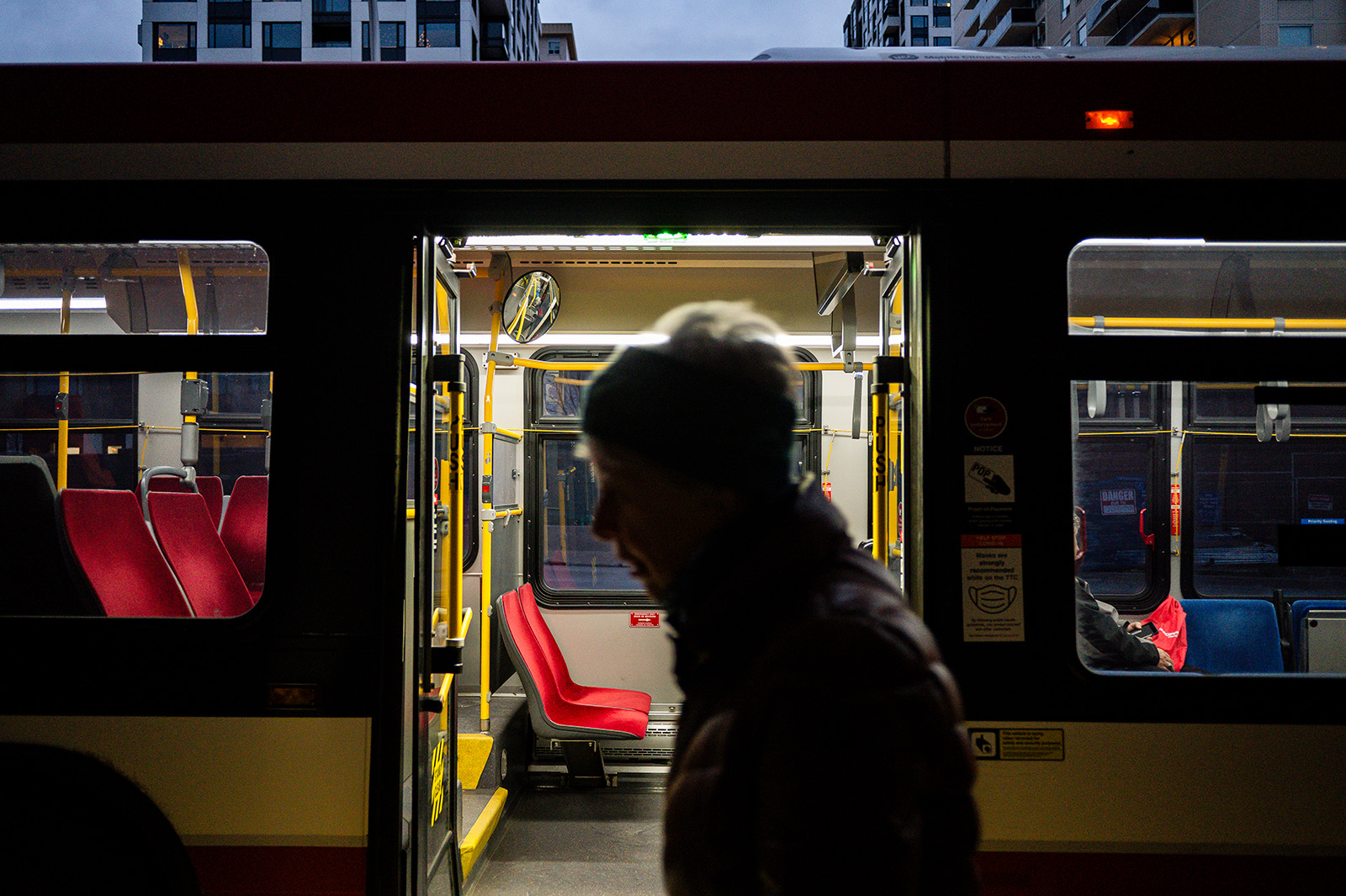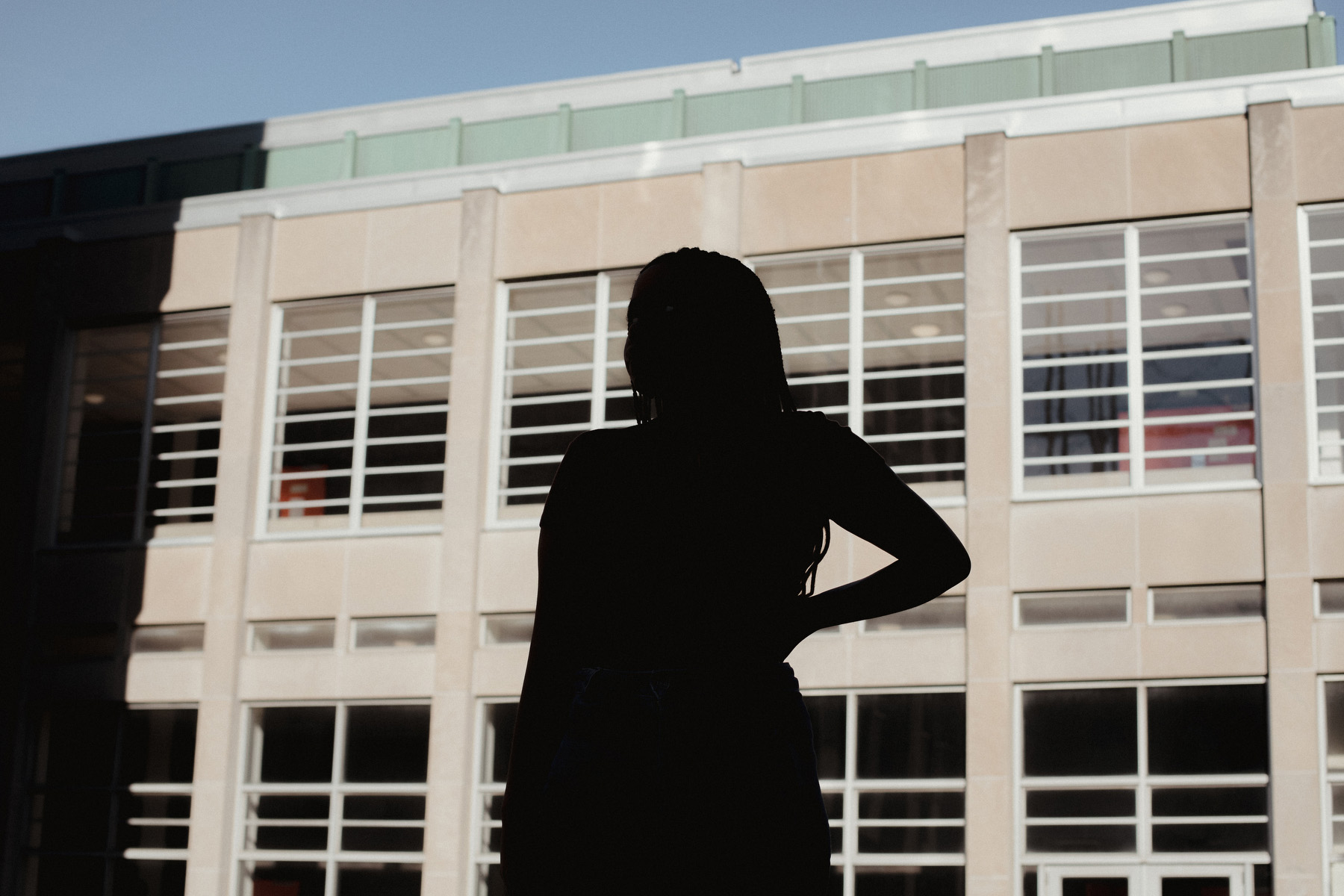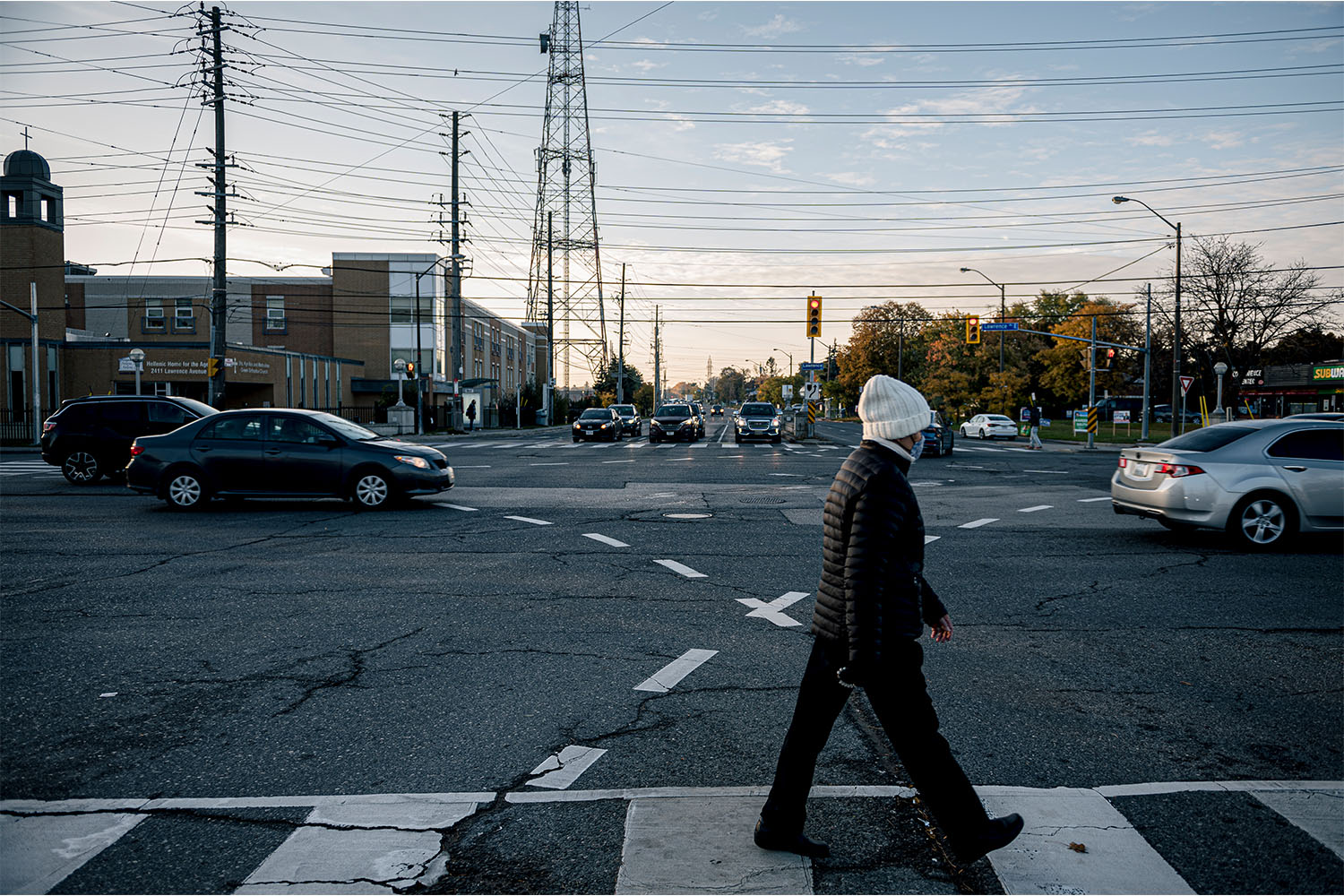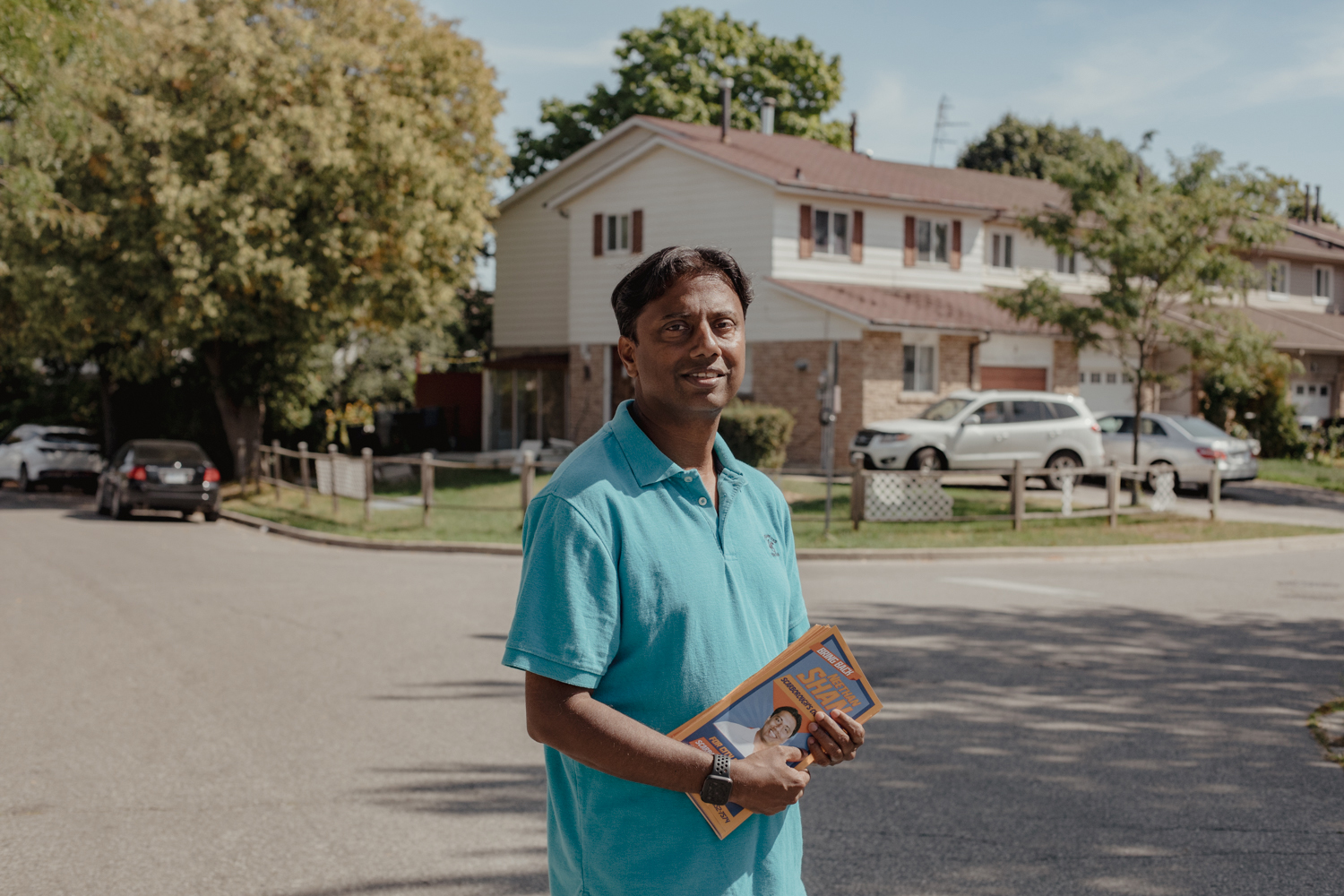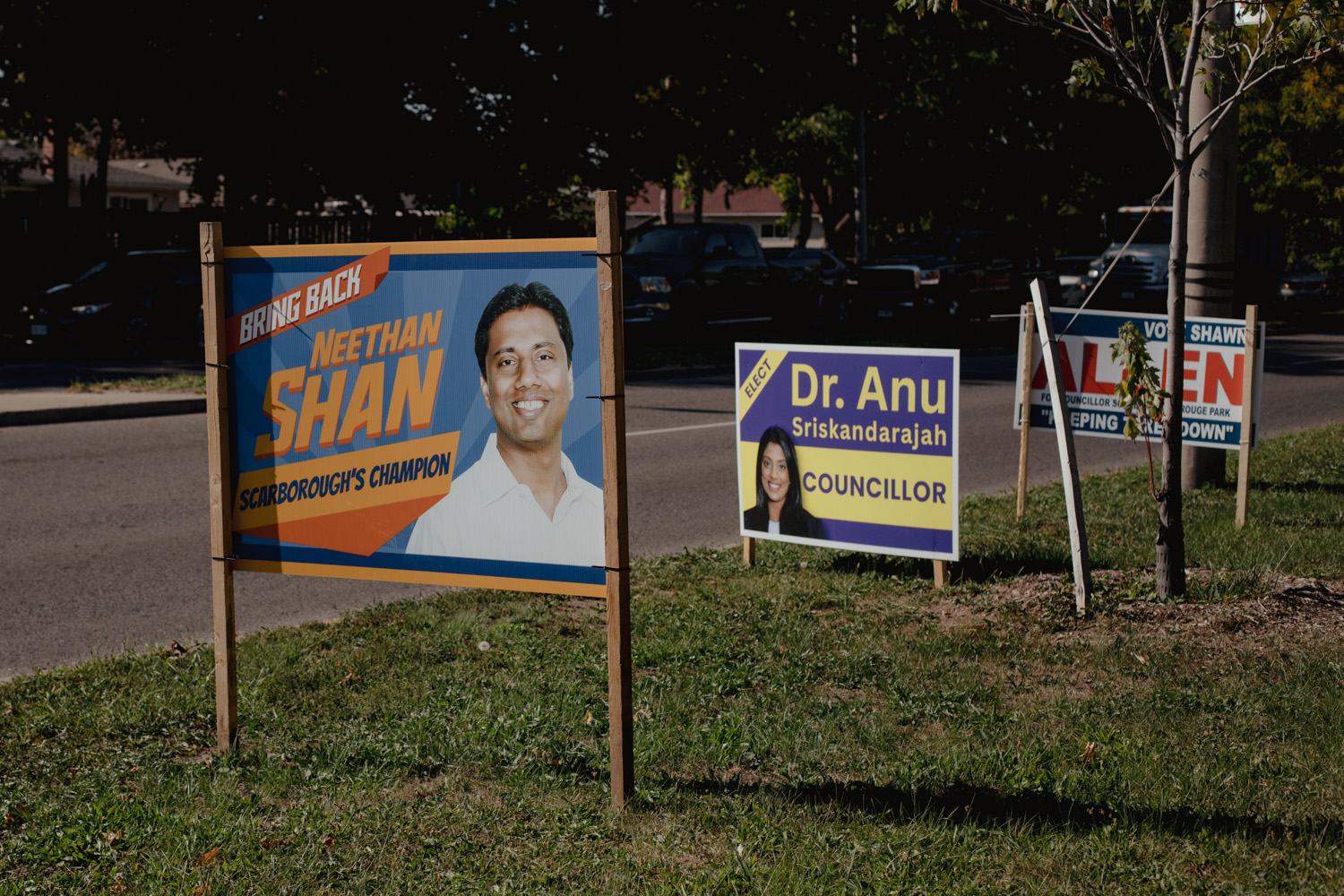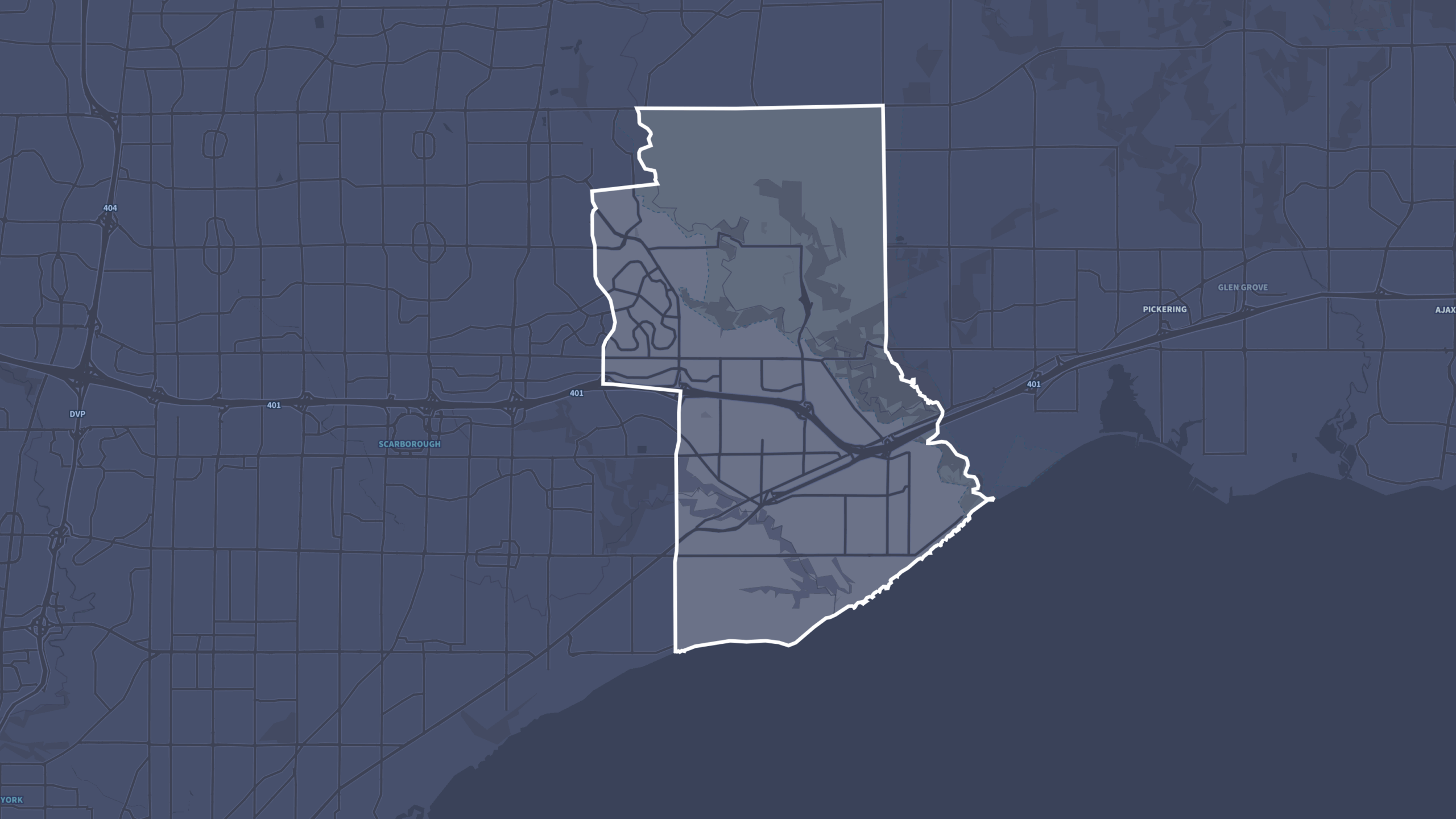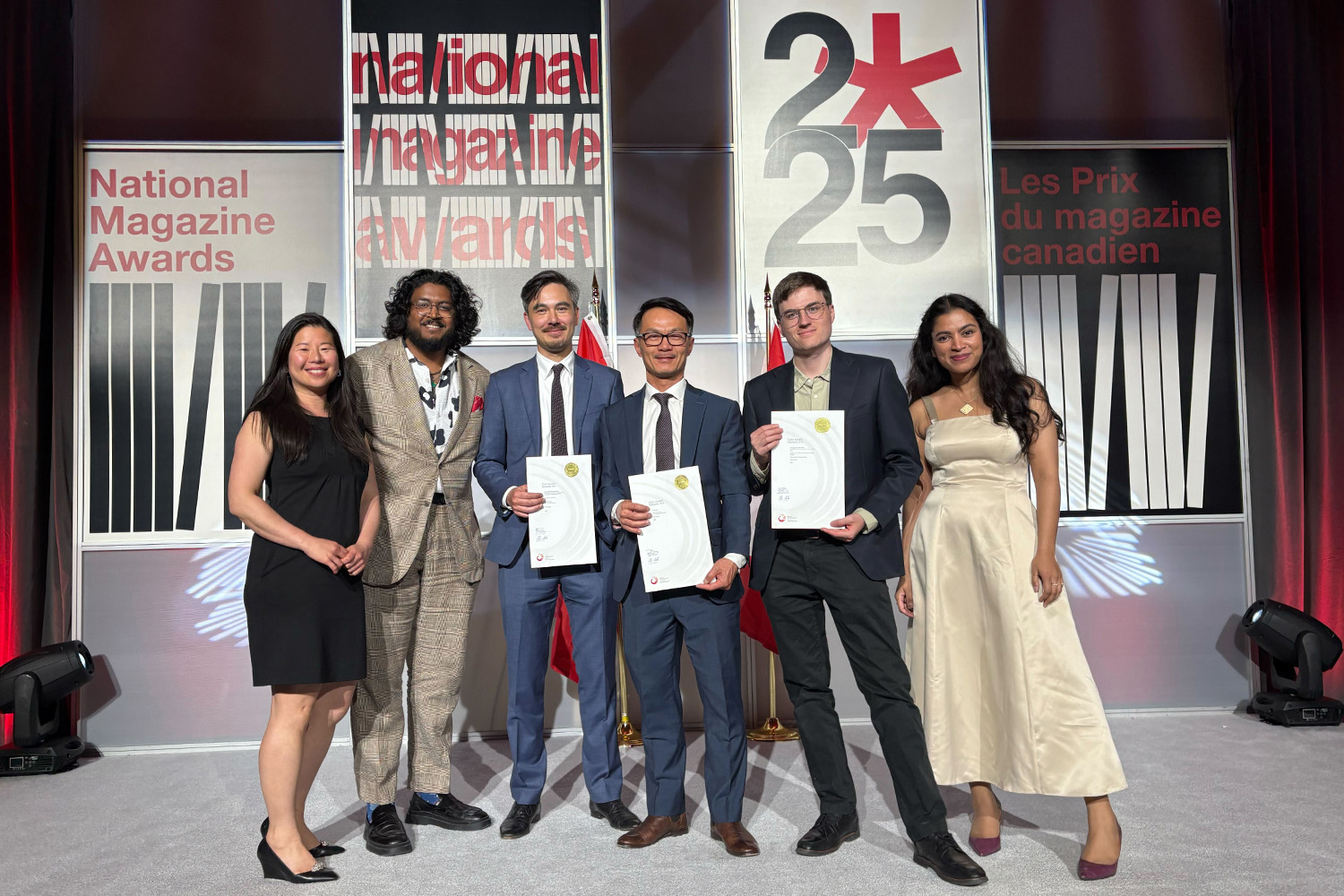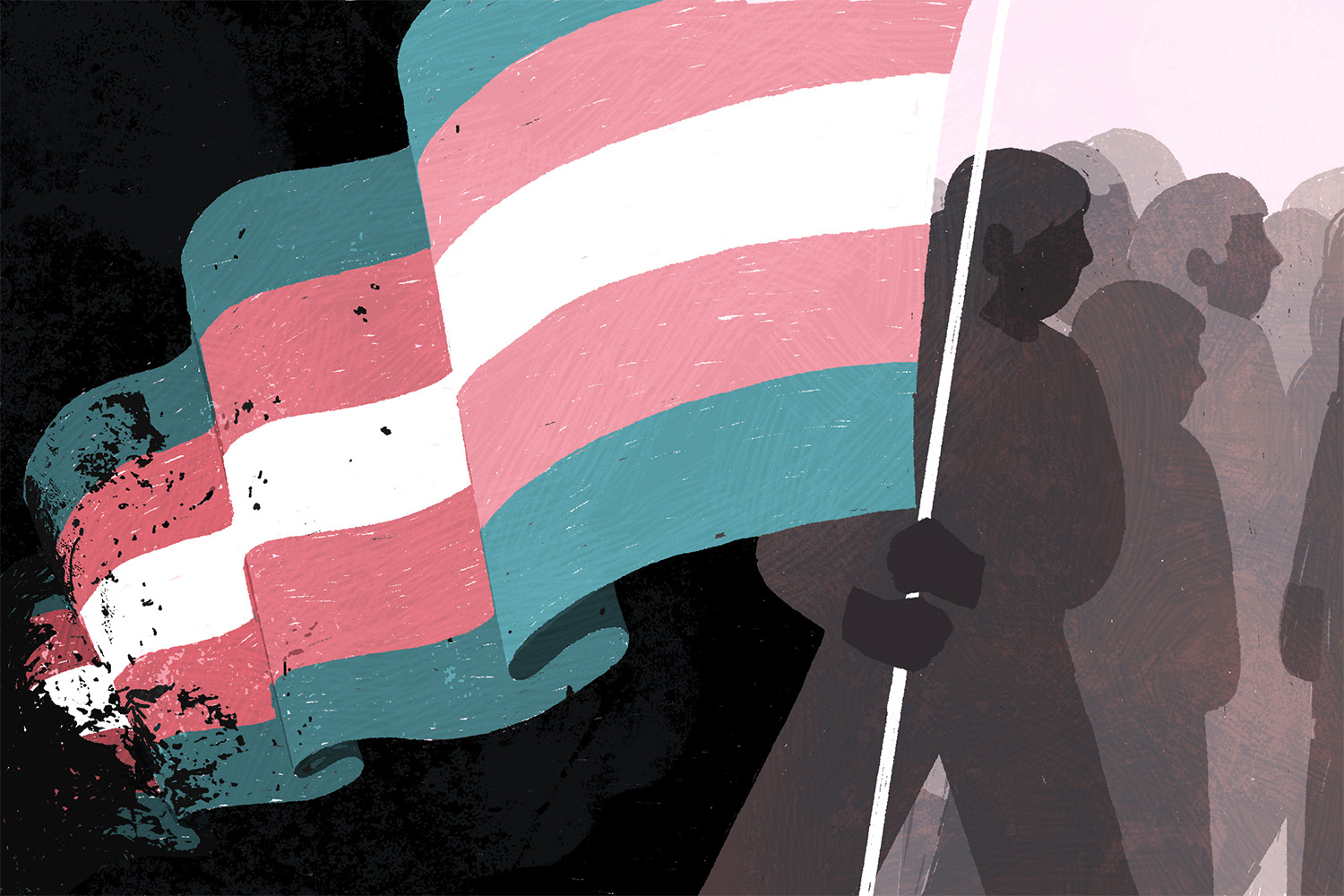

On the evening of the last Friday of June, thousands of Torontonians gathered downtown, waiting to march for Trans Pride. It was the final week of Pride month and the sky was cloudy, rain threatening to fall any minute. The buzzing crowd had gathered at the corner of Church and Isabella Streets, attendees draped in trans flags, multi-coloured outfits adorned with pins, carrying posters and banners with slogans like “Trans rights are human rights,” and “Pride is a protest.” Groups of friends gathered, introducing their partners, acquaintances, and comrades. A grandparent beamed as they met their trans grandchild’s friends.
That day, many in the crowd described this as the biggest turnout for Trans Pride that they’d ever seen. “It was massive,” said Samson Brown, a longtime trans advocate and multidisciplinary artist, in a later interview. “And it gets bigger every year, as more people start to acknowledge and realize that gender doesn’t have to be this straight, binary thing.”
This year’s Trans Pride march comes after a litany of attacks on Canada’s trans communities. Expected to pass this fall, Alberta’s recent proposals of anti-trans legislation seeking to block gender-affirming care for minors, including top and bottom surgeries, hormone therapies, and puberty blockers, are the latest in a rapid spread of transphobic governance across the country. In 2023, Saskatchewan introduced a new law requiring parental permission for students to informally change their name or pronouns in school to better reflect their gender identity. Premier Scott Moe indicated his immediate desire to use the notwithstanding clause—allowing the province to override the federal Charter of Rights and Freedoms—to protect the new pronoun policy. A similar change was made in New Brunswick, with the education minister threatening to dissolve any publicly elected education council that resists.
Conservative Party leader Pierre Poilievre has joined other political leaders, including British Prime Ministers Keir Starmer and Rishi Sunak, and U.S. former president Donald Trump, in advocating that trans women and girls be barred from women’s spaces and sports teams. In a matter of years, anti-trans sentiment—while not being new among conservatives—has become one of the main pillars of most right-wing political campaigns. And Canada’s intelligence agency, the Canadian Security Intelligence Service, warned last year that the growing movement against gender identity—against the acceptance of gender as a spectrum, and the distinction between sex and gender—could lead to domestic terrorism against queer and trans communities. The same anti-trans movement that has become a political force in America and Britain has gained ground in Canada, and these policies are shifting the social conversation on gender identity to the right in Ontario.
Toronto has long been considered, by many, to be a metropolitan bastion of inclusivity, largely safe from any regressive rhetoric or policy creeping through the rest of the country. But in reality, the Greater Toronto Area has served both as a refuge from and a breeding ground for anti-trans sentiment. The city has some of the most vibrant organizing for trans rights in the world and yet remains a hotbed for right-wing messaging, policy discussion, and pushback. Last September, transphobic protests targeted schools and children, around the same time that Premier Doug Ford delivered a speech arguing that school boards were “indoctrinating” students about gender issues and then-Education Minister Stephen Lecce signalled support for the anti-trans policies in other provinces. For years, Toronto-based influencers and pundits have been pillars of the North American anti-trans movement, but the initially fringe stance is being increasingly espoused by GTA politicians campaigning for school boards, city councils, and provincial seats. As the growing “culture war” around trans rights takes hold in Canada’s biggest city, trans activists are seeing the impact firsthand, and trying to build momentum to mobilize against these threats.
Join the thousands of Torontonians who've signed up for our free newsletter and get award-winning local journalism delivered to your inbox.
"*" indicates required fields
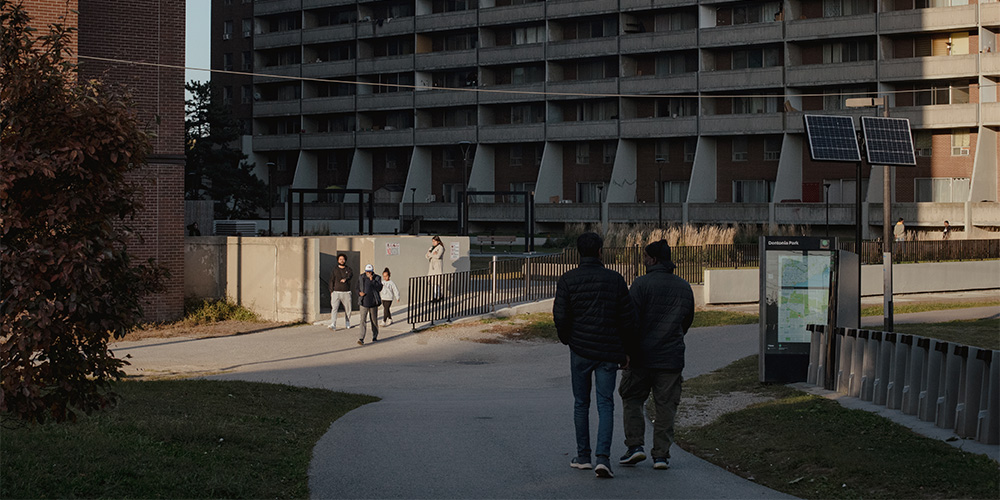
For trans people in Toronto, the rise in anti-trans sentiment is devastating but not necessarily surprising. Monica Forrester, a Black and 2-Spirit trans activist and sex worker in the city, and Executive Director of Trans Pride Toronto, has witnessed waves of transphobic rhetoric in Canada since the late 1980s. That era was the height of the HIV/AIDS epidemic, and many trans people in Toronto were experiencing homelessness, or turning to sex work to survive. “A lot of my peers have died in their early 20s, and still are dying before 30,” she said.
In her decades of activism, Forrester has worked across key Toronto organizations to demand justice for trans people, and to end transphobia in shelters, workplaces, streets, and political movements. And she has seen improvements over the years. “Things are changing, we’re seeing our survival going up more.” But trans people are still disproportionately at risk of violence, discrimination in employment and healthcare, and poverty compared to cisgender people.
“There’s still people experiencing violence in the community, there’s still people dying in our communities because of who they are,” Forrester said. And advocates warn that violence against trans people will only rise if anti-trans rhetoric and legislation are mainstreamed. Just last year, a former University of Waterloo student stabbed an instructor and two students in a gender studies class and destroyed a Pride flag, which the police described as “a hate-motivated incident related to gender expression and gender identity.”
The rise of transphobic rhetoric in Canada, and the resulting legislation, has emerged from an organized reactionary movement that transcends national borders (and often takes place online), led by radical right-wing social media figures, Christian nationalists, and gender essentialists, and espoused by decision-makers. In the last decade, as trans rights gained visibility through legislation like Bill C-16 and Toby’s Law, codifying protections for gender expression and identity, so grew the visibility of their opponents.
By the time Bill C-16, which moved to include gender identity and expression among Canada’s protected groups, received Royal Assent in 2017, a class of local Canadian pundits ranging from conservative to far-right were making an international name for themselves in anti-trans spaces, most notably psychologist and former University of Toronto professor Jordan Peterson, whose claim to fame was his refusal to use the right pronouns when referring to trans students, and his insistence that the separation of sex and gender was just “radically politically correct thinking.” Peterson became hugely popular among right-wing and incel communities online, at one point raking in $80,000 in monthly donations on Patreon. The compatibility of anti-trans sentiment with other elements of right-wing ideology also made it a mainstay in the political vernacular of commentators like Faith Goldy, whose views are primarily anti-immigration and have been described as white nationalist. Over the years, Goldy has used her platform to discredit trans-inclusionary policies like those proposed in Bill C-16, as well as gender-neutral washrooms and the right of trans people to be incarcerated in facilities corresponding to their gender, rather than birth sex.
Law professor Florence Ashley has lived across Quebec, Ontario, and now Alberta, where they write and lecture on trans peoples and the law. They caution against the idea that transphobia is a new phenomenon, or an American export.
“We shouldn’t overstate the level of safety that these larger urban centres actually provide,” they said.
As trans rights gained visibility through legislation like Bill C-16 and Toby’s Law, codifying protections for gender expression and identity, so grew the visibility of their opponents.
Rates of reported hate crimes against LGBTQ+ people in Toronto are higher today than they were pre-pandemic. While rates of reported hate crimes on the basis of gender identity are still relatively low, Toronto police figures show a doubling in sexual orientation-based hate crimes between 2022 and 2023. And these figures only account for crimes that have been reported to police, leaving out the myriad incidents that don’t make it to official channels—channels that have been known to previously mishandle and neglect violence against trans people.
“I think people really don’t understand just how dire things are for trans people just around Canada, period,” Ashley added. “And how [much] worse they’re getting with each passing year, even if we accept the thesis that Toronto is safer.”
What might have seemed like hand-wringing over pronouns and individual freedoms hid a careful and quiet realignment of gender and trans rights as a culture issue, with real material implications. In 2016, public polling showed overall support for trans rights and policies. But in the last year, that majority has decreased. Instead, there’s been a rise in misinformation, much of which has centred on young trans people and the well-being of children—myths about rates of post-transition regret and “detransitioning,” about trans people committing violence, and panic that irreversible gender-affirming care is too easily being offered to minors (it’s not). These narratives, whether circulated in legislative bodies, social media, or parent group chats, rely on aggravating cisgender Canadians’ ignorance and discomfort with gender, bodies, and sex.
Schools have been a particularly ugly site of transphobic rhetoric in recent years. In the Greater Toronto Area, concerns over Pride flags and sex and gender curricula have surfaced in the suburbs. In June of this year, trustees from the Dufferin-Peel Catholic School Board voted down flying the Pride flag outside of schools, as did the York Catholic School District Board last year and Halton Catholic two years before that. At the beginning of the 2023-24 school year, the 1MillionMarch4Children group—which included conservative attendees from a variety of demographic backgrounds, including many racialized people—organized rallies outside of schools, protesting “gender ideology.” The group claims to want to “protect children,” stoking fear among some uninformed parents and activating others who already oppose comprehensive sex education to remind schools “whose children [the students] are.” Public school boards including Toronto, Peel, Halton, and Durham all raised the Pride flag in response and counter-protestors organized quickly to outnumber the march.
Inertia, Ashley says, can in some ways cause as much harm as the transphobia it’s failing to address. The changing social conversation on trans rights has had a chilling effect on any momentum that could have been built on the gender-inclusive legislative wins seen in 2016.
NDP MPP Kristyn Wong-Tam has struggled against this inertia in Queen’s Park.
“Where we are in Ontario is a very dangerous intersection,” they said. Wong-Tam, the 2SLGBTQ+ Issues critic for the province, is a former Toronto city councillor for Toronto Centre and the first openly non-binary person to hold a seat in the Legislature.
Wong-Tam says it’s not enough for political leaders not to be transphobic—at a time of rampant misinformation and growing hostility, there needs to be an active move to counter such rhetoric and publicly affirm a commitment to Ontario’s trans population. “Although Mr. Ford and his government [are] not actively denouncing the use of pronouns, and although they’re not introducing new legislation to revoke trans rights,…they are not proposing anything that will enhance trans human rights, including a right to healthcare,” they said.
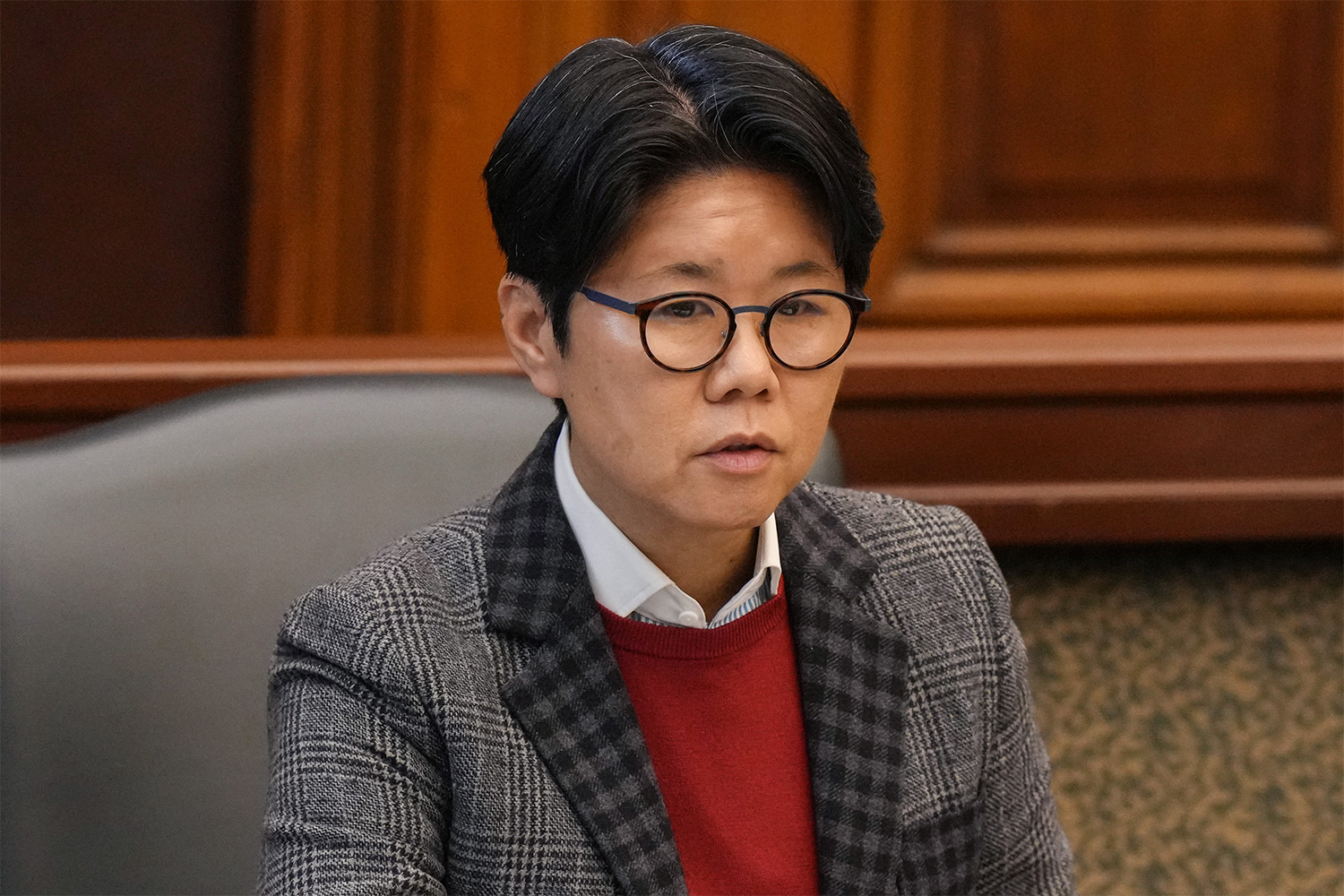
Since first being elected in 2022, Wong-Tam has sought to introduce private members’ bills that protect drag queens from the organized protests and hate speech outside their shows, guarantee mental health care for LGBTQ+ youth, and build gender-affirming care in our healthcare system. But the provincial Conservative super-majority makes private members’ bills difficult to pass.
In a February 2024 session, just weeks after Alberta’s announcement restricting gender-affirming healthcare for young people, Wong-Tam reintroduced Bill 42 which, if passed, would have established an advisory committee for gender-affirming care, recommending solutions and policy changes to the minister of health. In the debates, Wong-Tam specifically addressed the misinformation perpetuated by Alberta and New Brunswick’s premiers on trans youth.
At a previous reading in 2021, Conservative MPPs had supported the same bill, which failed to pass only after the government stalled until the legislative session ended. But in 2023 the bill was criticized by Conservative MPPs who argued for the healthcare needs of “all Ontarians” and noted trans healthcare needs were already covered by the province. The bill failed.
“We have absolutely lost ground…By them deliberately voting down gender-friendly healthcare, when they supported it last time at the same second meeting, tells me that they’re sending a message to their homophobic supporters and transphobic supporters,” said Wong-Tam. “They’re sending a very clear message that this government is actively not an ally, actively not supportive of even a review of the healthcare system.”
Wong-Tam’s concerns around LGBTQ+ safety have previously been shot down by conservative ministers using the same justification that trans rights are enshrined within those of “all communities”—ignoring the clear threats to queer communities emerging across the province.
“Despite the fact that this government is not whipping up absolute hysteria and hate against the trans community, we should never ever take someone’s silence as support,” said Wong-Tam. “Them not whipping up transphobia is no sign of allyship.”
When trans people have to fight to justify their very existence, to argue for basic protections and rights, any greater needs go unheard. Many live in precarious circumstances, and don’t feel safe seeking support through official channels like the police, or can’t afford to sue their employer, quit their job, change healthcare providers or school boards, or use the language of the law to navigate hostile environments. As numerous trans advocates pointed out to me—the goal isn’t just to survive, it’s to thrive.
That’s where local organizing comes in. Across the city, trans communities have developed programs, support systems, and advocacy channels for trans people from every walk of life. This work takes place both in grassroots and established environments: in refugee resettlement efforts, protests, artmaking, shows, sports teams, employment programs, healthcare clinics, and myriad other sites. Addressing the global rise of transphobia locally has required a shift in organizing and coalition-building.
Social worker Terrence Rodriguez grew up in Rexdale, the child of a single mother. He came out as trans in the early 2000s, coming of age in an era when there was scarce open conversation about trans identity and even poorer access to trans healthcare, especially in the inner suburbs.
“Everything’s centralized. Everything’s localized downtown,” he said. “The city forgets all these different communities and pockets and areas.”
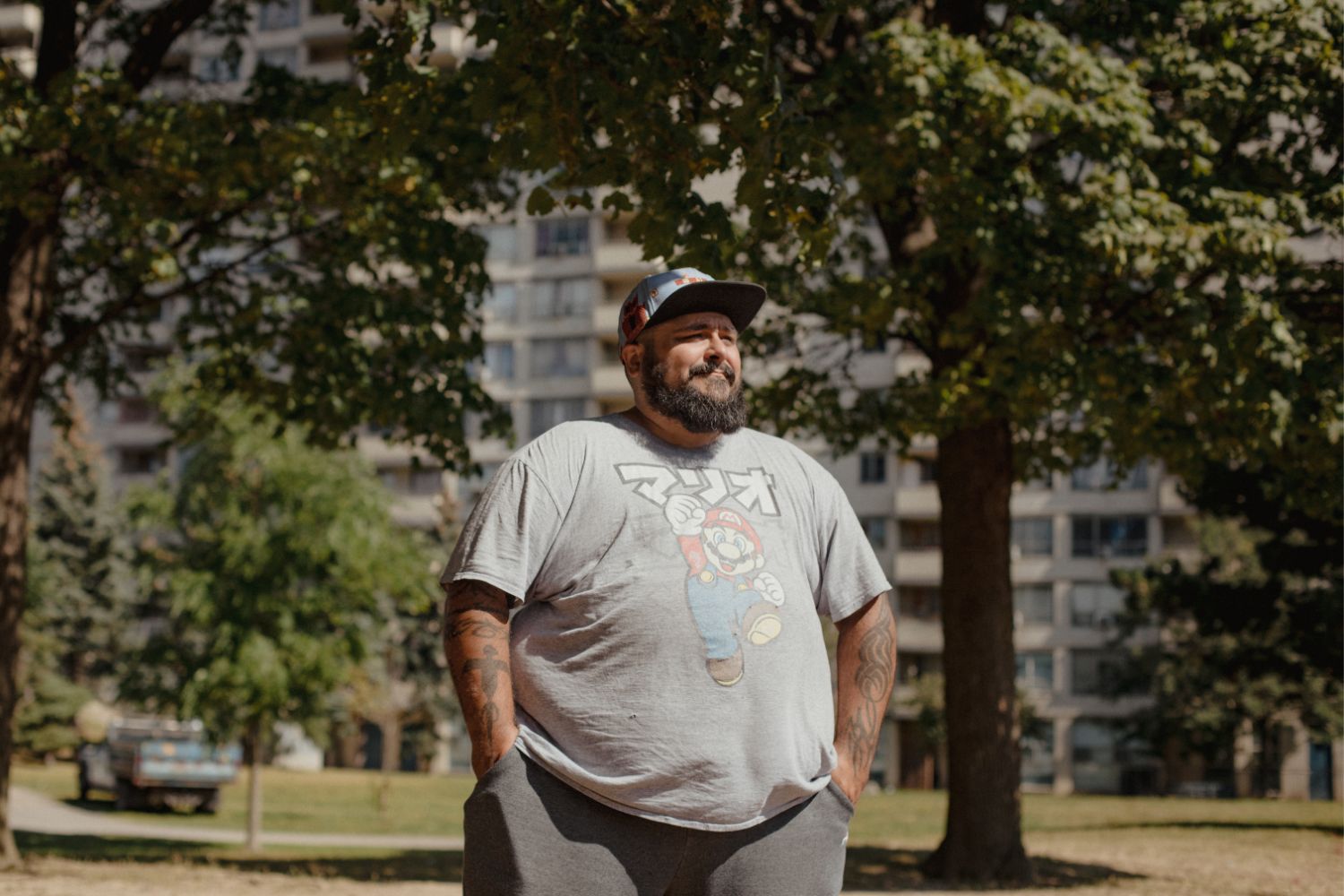
In circumstances like these, Rodriguez says, trans people have to become experts and advocates for their own healthcare. And in Toronto neighbourhoods without visible LGBTQ+ presence, youth can’t as easily build community, make new connections, and live openly and assertively in the same ways as others. His experience in the suburbs led him to develop REX Pride and its programs, working with the Rexdale Community Health Centre to directly reach youth and local residents.
The program, which first began 12 years ago with just a few chairs and scarcely any attendees, has turned into a forum for community-building, exploring identity, discussing political philosophies, and helping get attendees the resources they need, including gender-affirming medical care.
Year after year, Rodriguez has seen the changes. This year is the first that he’s seen trans youth attend the program whose parents are supportive of their identities—many of the youth Rodriguez works with live in shelters or are in the care of the Children’s Aid Society, and face threats of conversion therapy and repression from their family. They lean on Rodriguez when they have no one else to turn to. A few months ago, he was at a wedding in Colombia when one of these kids called him, reluctant to talk openly with their guidance counselor. But Rodriguez is worried about his and REX Pride’s capacity.
Though the recent rise and legitimization of transphobia doesn’t shock Rodriguez, the ripple effects are exhausting, straining a community program that is already struggling to respond to the lasting mental health impacts of the pandemic on youth and isn’t getting adequate funding to meet its needs. The result is the same sense of unresponsiveness Ashley and Wong-Tam have seen in their lines of work.
“Everybody in Rexdale talks about settlement, newcomer services, mental health and violence, ” Rodriguez said. Despite the increasing need for an intersectional approach to these issues, he said, there’s a challenge, and often a resistance, to bringing conversations about gender and sexuality into this setting. “You’re trying to engage youth that are, say, at risk of joining gangs. You don’t go ‘Hey, by the way, are you gay?’”
Rodriguez has helped develop gender diverse and inclusive policies at the Toronto Police Service and Toronto District School Board, and he’s seen firsthand how gaps in these major Ontario institutions have resulted in a failure to be materially accountable to trans people—to tackle the challenges they face in schools, or to be responsive in cases of discrimination or harassment. This means trans organizers across the province have to step in where institutions fail, stretching thin their existing funding, power, and influence. Securing trans rights and resources is already an uphill battle. To introduce policies resembling those from Alberta, Saskatchewan, and New Brunswick, into this strained, inertia-ridden environment, Rodriguez fears, would be a “death sentence” for the communities he serves.
With the school year just starting, LGBTYouthLine Executive Director Lauren Pragg has been following the rise of transphobia closely. To Pragg, last year’s demonstrations felt like an undoing of whatever small progress had been made in Ontario classrooms, despite the many Ontarians who joined the counter-protests, vocal in their support of trans youth. For years, YouthLine has been running programs, research initiatives, and outreach events to bring awareness to LGBTQ+ youth’s experiences. The organization spoke with more than 1,000 Ontario LGBTQ+ kids for a 2021 research report. At the top of the list of resulting recommendations: better access to mental health services for trans youth, increased representation of LGBTQ+ youth in decision-making processes, and dedicated resources in suburban and rural areas.
Since trans children face increased risk of bullying, suicide, and homelessness, Pragg emphasized the need for better institutional response. This year, YouthLine has been campaigning with other LGBTQ+ organizations and teacher’s unions, and at back-to-school fairs for their letter-writing Write for Student Rights Campaign to ensure queer and trans youth are safe in schools.
“Within the last few years, there have been calls to remove safe space stickers from classrooms, multiple school boards have decided not to fly the Pride flag during June, restrictions have been placed on 2SLGBTQ+ books,” the letter reads. Enshrining the rights of LGBTQ+ youth in schools means ensuring an inclusive school curriculum, access to safe and gender-affirming school facilities and extracurriculars like bathrooms and sports teams, and a refusal to entertain policy changes that erode existing rights.
“We want young people to also know that we’re paying attention, that they’re not alone in this, that they’re not being forgotten,” Pragg said. “We want to make sure that we’re getting ahead of it…and there’s a kind of critical mass behind that approach.”
This week, on Sept. 20, anti-trans activists are planning another 1MillionMarch4Children. Like last year, trans community members and allies alike are preparing to counter-protest: to show up in bigger numbers, drown out a vocal, transphobic minority, and shift focus from the reactionary right to the material needs of the trans community. The advocates I spoke to emphasized that action—preventing transphobic misinformation before it takes hold, creating spaces of inclusion and improving living conditions, organizing among trans communities and allies, and adequately funding all these efforts—is the key to hope and resilience.
“The more we’re able to see change, it might come with some setbacks, some resistance,” says Monica Forrester, executive director of Trans Pride Toronto. “But we need to stay a force to be reckoned with.”

